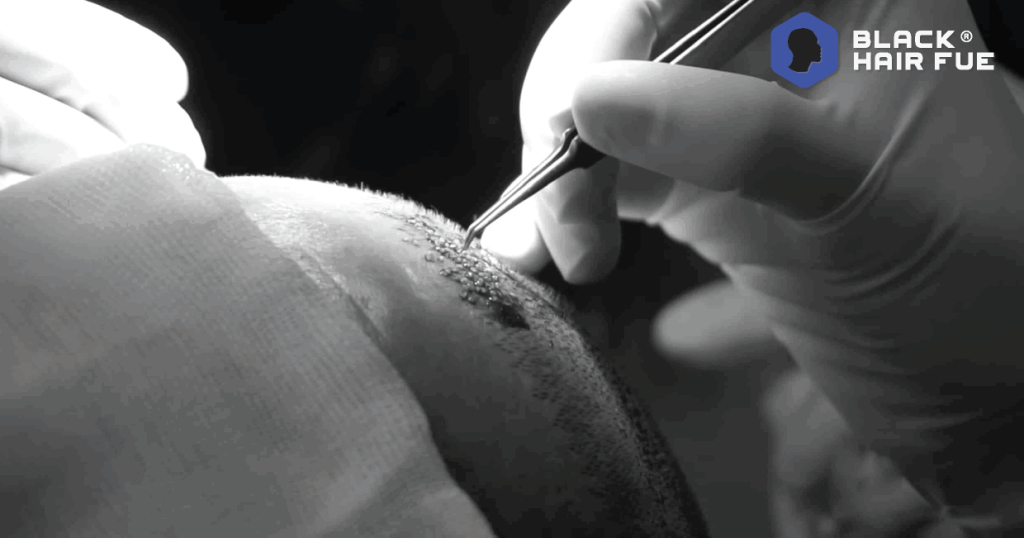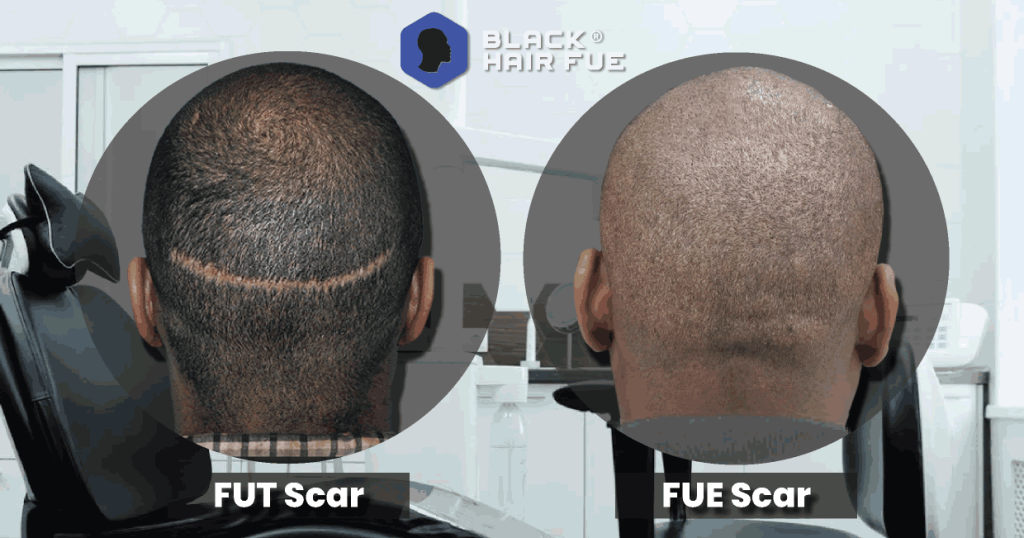FUE vs Strip Method for Black Hair
Hair transplantation has become an increasingly popular solution for individuals experiencing hair loss, including those in the Black community. The two primary methods of hair transplantation are Follicular Unit Extraction (FUE) and Follicular Unit Transplantation (FUT). In this article, we will compare these two techniques, discussing their differences, advantages, disadvantages, and considerations specific to Black patients.
FUE and FUT are both hair transplantation methods that aim to restore hair in balding or thinning areas. However, they differ in their approach to harvesting donor hair follicles.
Follicular Unit Extraction (FUE): In the FUE method, individual hair follicles are extracted directly from the donor area (usually the back and sides of the scalp) using a specialized punch tool. The follicles are then transplanted into the recipient area one by one. FUE is a newer technique that has gained popularity in recent years due to its minimally invasive nature and reduced scarring.
Follicular Unit Transplantation (FUT): Also known as the strip method, FUT involves removing a strip of skin containing hair follicles from the donor area. The strip is then dissected under a microscope to isolate individual follicular units, which are then transplanted into the recipient area. FUT has been the traditional method of hair transplantation for decades.

Graft Quality Comparison
The quality of the harvested grafts is crucial for the success of a hair transplant. In general, both FUE and FUT can provide high-quality grafts when performed by a skilled surgeon. However, there are some differences to consider:
- FUE allows for more precise extraction of individual follicular units, which can lead to better graft survival rates and more natural-looking results.
- FUT grafts may have a slightly higher transection rate (damage to the follicles) due to the strip harvesting process, but this can be minimized by an experienced surgeon.
Advantages and Disadvantages
FUE Advantages:
- Minimally invasive procedure with faster recovery time
- No linear scar in the donor area
- Ability to wear shorter hairstyles without visible scarring
- Suitable for patients with limited donor hair or tight scalp skin
FUE Disadvantages:
- More time-consuming and labor-intensive procedure
- Higher cost compared to FUT
- Requires a larger donor area for harvesting
FUT Advantages:
- Allows for a larger number of grafts to be harvested in a single session
- Lower cost compared to FUE
- Suitable for patients with extensive hair loss
FUT Disadvantages:
- Leaves a linear scar in the donor area
- Longer recovery time compared to FUE
- Limited hairstyle options due to the presence of a scar
- Higher risk of complications such as wound healing issues and numbness
Cost Comparison
The cost of hair transplantation varies depending on factors such as the number of grafts needed, the surgeon’s experience, and the geographic location. On average, FUE tends to be more expensive than FUT due to the time-consuming nature of the procedure and the specialized skills required. However, the cost difference between the two methods has been narrowing in recent years as FUE technology advances and becomes more widely available.
Here are some rough cost estimates for FUE and FUT hair transplants around the world:
- 🇺🇸 United States: FUE – $4,000 to $15,000; FUT – $3,000 to $10,000
- 🇬🇧 United Kingdom: FUE – £3,000 to £10,000; FUT – £2,000 to £8,000
- 🇹🇷 Turkey: FUE – $1,500 to $5,000; FUT – $1,000 to $4,000
- 🇮🇳 India: FUE – $1,000 to $4,000; FUT – $800 to $3,000
- 🇨🇴 Colombia: FUE – $1,800 to $6,000; FUT – $1,500 to $5,000
- 🇨🇴 Panama: FUE – $2,000 to $7,000; FUT – $1,800 to $6,000
- 🇲🇽 Mexico: FUE – $2,500 to $8,000; FUT – $2,000 to $7,000
It’s important to note that while cost is a consideration, it should not be the sole deciding factor when choosing a hair transplant method or surgeon. The expertise and experience of the surgeon, as well as their understanding of the unique needs of Black hair and scalp, should be prioritized to ensure the best possible results.
Recovery Process and Scarring
The recovery process and scarring are important factors to consider when comparing FUE and FUT hair transplants, especially for Black patients who may be prone to keloid scarring.
FUE Recovery and Scarring:
- Minimal downtime, with most patients able to return to work within a few days
- No linear scar, as the extraction sites heal as small, circular scars that are less visible
- Lower risk of keloid scarring compared to FUT
- Some post-procedure swelling and redness, which typically subsides within a week
FUT Recovery and Scarring:
- Longer recovery time, with patients typically requiring 10-14 days before returning to work
- Linear scar in the donor area, which can be visible if the hair is worn short
- Higher risk of keloid scarring, particularly in Black patients
- Possible numbness and tightness in the donor area, which may take several months to resolve

The Best Choice for Black Patients
When considering FUE vs. FUT for Black patients, several factors come into play. Black hair tends to be curly, coarse, and more prone to damage, while the scalp may have a higher risk of keloid scarring. These characteristics can impact the success of a hair transplant and should be carefully considered when choosing a method and surgeon.
In general, FUE may be the preferred choice for Black patients due to:
- Lower risk of keloid scarring: The small, circular scars left by FUE are less likely to develop into keloids compared to the linear scar from FUT.
- Ability to wear shorter hairstyles: With no linear scar, FUE allows for more flexibility in hairstyle choices post-transplant.
- Precise graft extraction: FUE enables the surgeon to carefully select and extract follicular units while minimizing damage to the curly, coarse hair.
However, the best choice ultimately depends on the individual patient’s needs, goals, and the recommendations of a qualified hair transplant surgeon experienced in working with Black hair and scalp. A thorough consultation and evaluation can help determine the most suitable method for each patient.
FUE and FUT are both viable hair transplantation methods that can help Black patients achieve their hair restoration goals. While FUE may offer advantages such as lower keloid scarring risk and more natural-looking results, the best choice depends on various factors unique to each individual. By understanding the differences between these methods and consulting with a skilled hair transplant surgeon, Black patients can make an informed decision and take a confident step towards a fuller, more youthful head of hair.





